Water-Droplet Impact and Sliding Behaviors on Slippery Surfaces with Various Weber Numbers and Surface Inclinations
Abstract
1. Introduction
2. Materials and Methods
3. Results and Discussion
3.1. Morphology and Wettability
3.2. Effect of We Numbers on the Water-Droplet-Impact Behaviors
3.3. Effect of Surface Inclinations on the Water-Droplet Impact and Sliding Behaviors
4. Conclusions
Author Contributions
Funding
Institutional Review Board Statement
Informed Consent Statement
Data Availability Statement
Conflicts of Interest
References
- Parkin, I.P.; Palgrave, R.G. Self-cleaning coatings. J. Mater. Chem. 2005, 15, 1689. [Google Scholar] [CrossRef]
- Ganesh, V.A.; Raut, H.K.; Nair, A.S.; Ramakrishna, S. A review on self-cleaning coatings. J. Mater. Chem. 2011, 21, 16304. [Google Scholar]
- Sethi, S.K.; Manik, G. Recent progress in super hydrophobic/hydrophilic self-cleaning surfaces for various industrial applications: A review. Polym.-Plast. Technol. Eng. 2018, 57, 1932–1952. [Google Scholar] [CrossRef]
- Sethi, S.K.; Kadian, S.; Goel, A.; Chauhan, R.P.; Manik, G. Fabrication and analysis of zno quantum dots based easy clean coating: A combined theoretical and experimental investigation. ChemistrySelect 2020, 5, 8942–8950. [Google Scholar] [CrossRef]
- Meng, J.; Zhang, P.; Zhang, F.; Liu, H.; Fan, J.; Liu, X.; Yang, G.; Jiang, L.; Wang, S. A self-cleaning TiO2 nanosisal-like coating toward disposing nanobiochips of cancer detection. ACS Nano 2015, 9, 9284–9291. [Google Scholar] [CrossRef]
- Wong, T.S.; Kang, S.H.; Tang, S.K.; Smythe, E.J.; Hatton, B.D.; Grinthal, A.; Aizenberg, J. Bioinspired self-repairing slippery surfaces with pressure-stable omniphobicity. Nature 2011, 477, 443–447. [Google Scholar] [CrossRef]
- Cheng, S.; Guo, P.; Wang, X.; Che, P.; Han, X.; Jin, R.; Heng, L.; Jiang, L. Photothermal slippery surface showing rapid self-repairing and exceptional anti-icing/deicing property. Chem. Eng. J. 2022, 431, 133411. [Google Scholar] [CrossRef]
- Wei, C.; Jin, B.; Zhang, Q.; Zhan, X.; Chen, F. Anti-icing performance of super-wetting surfaces from icing-resistance to ice-phobic aspects: Robust hydrophobic or slippery surfaces. J. Alloys Compd. 2018, 765, 721–730. [Google Scholar]
- Nguyen, T.-B.; Park, S.; Jung, Y.; Lim, H. Effects of hydrophobicity and lubricant characteristics on anti-icing performance of slippery lubricant-infused porous surfaces. J. Ind. Eng. Chem. 2019, 69, 99–105. [Google Scholar]
- Coady, M.J.; Wood, M.; Wallace, G.Q.; Nielsen, K.E.; Kietzig, A.M.; Lagugne-Labarthet, F.; Ragogna, P.J. Icephobic behavior of uv-cured polymer networks incorporated into slippery lubricant-infused porous surfaces: Improving slips durability. ACS Appl. Mater. Interfaces 2018, 10, 2890–2896. [Google Scholar]
- Kim, J.H.; Kim, M.J.; Lee, B.; Chun, J.M.; Patil, V.; Kim, Y.-S. Durable ice-lubricating surfaces based on polydimethylsiloxane embedded silicone oil infused silica aerogel. Appl. Surf. Sci. 2020, 512, 145728. [Google Scholar] [CrossRef]
- Xiang, H.; Yuan, Y.; Zhang, C.; Dai, X.; Zhu, T.; Song, L.; Gai, Y.; Liao, R. Key factors affecting durable anti-icing of slippery surfaces: Pore size and porosity. ACS Appl. Mater. Interfaces 2022, 15, 3599–3612. [Google Scholar] [CrossRef] [PubMed]
- Xu, Y.; Li, X.; Wang, X.; Luo, Z.; Liao, J.; Tao, Y.; Xu, M. Synergistic effect of micro–nano surface structure and surface grafting on the efficient fabrication of durable super-hydrophobic high-density polyethylene with self-cleaning and anti-icing properties. Appl. Surf. Sci. 2023, 611, 155654. [Google Scholar] [CrossRef]
- Chao, Q.; Meng, L.; Shuxian, C. Anti-Icing Characteristics of PTFE Super Hydrophobic Coating on Titanium Alloy Surface. J. Alloys Compd. 2021, 860, 157907. [Google Scholar] [CrossRef]
- Yuan, Y.; Xiang, H.; Liu, G.; Liao, R. Fabrication of phase change microcapsules and their applications to anti-icing coating. Surf. Interfaces 2021, 27, 101516. [Google Scholar] [CrossRef]
- Bakbolat, B.; Daulbayev, C.; Sultanov, F.; Taurbekov, A.; Tolynbekov, A.; Yeleuov, M.; Korobeinyk, A.V.; Mansurov, Z. Effectiveness of bio-waste-derived carbon doping on de-icing performance of an electrically resistant concrete. Coatings 2022, 12, 1629. [Google Scholar] [CrossRef]
- Kenzhebayeva, A.; Bakbolat, B.; Sultanov, F.; Daulbayev, C.; Mansurov, Z. A mini-review on recent developments in anti-icing methods. Polymers 2021, 13, 4149. [Google Scholar] [CrossRef] [PubMed]
- Ma, L.; Zhang, Z.; Gao, L.; Liu, Y.; Hu, H. An exploratory study on using Slippery-Liquid-Infused-Porous-Surface (SLIPS) for wind turbine icing mitigation. Renew. Energy 2020, 162, 2344–2360. [Google Scholar] [CrossRef]
- Yuan, Y.; Xiang, H.; Liu, G.; Wang, L.; Liu, H.; Liao, R. Self-repairing performance of slippery liquid infused porous surfaces for durable anti-icing. Adv. Mater. Interfaces 2022, 9, 2101968. [Google Scholar] [CrossRef]
- Yuan, Y.; Wang, L.; Liu, G.Y.; Liao, R.J. Fabrication of ultralow ice-adhesion slippery liquid infused porous surfaces on aluminum alloy (7075-t651). Coatings 2020, 10, 1025. [Google Scholar] [CrossRef]
- Liu, G.Y.; Yuan, Y.; Liao, R.J.; Wang, L.; Gao, X. Fabrication of a porous slippery icephobic surface and effect of lubricant viscosity on anti-icing properties and durability. Coatings 2020, 10, 896. [Google Scholar] [CrossRef]
- Zhang, J.; Wu, L.; Li, B.; Li, L.; Seeger, S.; Wang, A. Evaporation-induced transition from Nepenthes pitcher-inspired slippery surfaces to lotus leaf-inspired superoleophobic surfaces. Langmuir 2014, 30, 14292–14299. [Google Scholar] [CrossRef]
- Luo, H.; Yin, S.; Huang, S.; Chen, F.; Tang, Q.; Li, X. Fabrication of slippery Zn surface with improved water-impellent, condensation and anti-icing properties. Appl. Surf. Sci. 2019, 470, 1139–1147. [Google Scholar] [CrossRef]
- Tang, L.; Wang, N.; Sun, H.; Xiong, D. Superhydrophobic surfaces with flake-like structures and lubricant-infused composite surfaces to enhance anti-icing ability. Chem. Phys. Lett. 2020, 758, 137903. [Google Scholar] [CrossRef]
- Cao, M.; Guo, D.; Yu, C.; Li, K.; Liu, M.; Jiang, L. Water-repellent properties of superhydrophobic and lubricant-infused “slippery” surfaces: A brief study on the functions and applications. ACS Appl. Mater. Interfaces 2016, 8, 3615–3623. [Google Scholar] [CrossRef]
- Yin, C.; Wang, T.; Che, Z.; Jia, M.; Sun, K. Oblique impact of droplets on microstructured superhydrophobic surfaces. Int. J. Heat Mass Transfer 2018, 123, 693–704. [Google Scholar] [CrossRef]
- Zhang, R.; Hao, P.; Zhang, X.; He, F. Supercooled water droplet impact on superhydrophobic surfaces with various roughness and temperature. Int. J. Heat Mass Transfer 2018, 122, 395–402. [Google Scholar] [CrossRef]
- Cao, Y.; Jana, S.; Tan, X.; Bowen, L.; Zhu, Y.; Dawson, J.; Han, R.; Exton, J.; Liu, H.; McHale, G.; et al. Antiwetting and antifouling performances of different lubricant-infused slippery surfaces. Langmuir 2020, 36, 13396–13407. [Google Scholar] [CrossRef]
- Multanen, V.; Whyman, G.; Shulzinger, E.; Valtsifer, V.; Bormashenko, E. Plasma treatment of silicone oil- infused surfaces switches impact of water droplets from bouncing to tanner-like spreading. Colloids Surf. A 2018, 538, 133–139. [Google Scholar] [CrossRef]
- Muschi, M.; Brudieu, B.; Teisseire, J.; Sauret, A. Drop impact dynamics on slippery liquid-infused porous surfaces: Influence of oil thickness. Soft Matter 2018, 14, 1100–1107. [Google Scholar] [CrossRef]
- Kim, J.H.; Rothstein, J.P. Droplet impact dynamics on lubricant-infused superhydrophobic surfaces: The role of viscosity ratio. Langmuir 2016, 32, 10166–10176. [Google Scholar] [CrossRef] [PubMed]
- Lee, C.; Kim, H.; Nam, Y. Drop impact dynamics on oil-infused nanostructured surfaces. Langmuir 2014, 30, 8400–8407. [Google Scholar] [CrossRef] [PubMed]
- Sunny, S.; Vogel, N.; Howell, C.; Vu, T.L.; Aizenberg, J. Lubricant-infused nanoparticulate coatings assembled by layer-by-layer deposition. Adv. Funct. Mater. 2014, 24, 6658–6667. [Google Scholar] [CrossRef]
- Anand, S.; Paxson, A.T.; Dhiman, R.; Smith, J.D.; Varanasi, K.K. Enhanced condensation on lubricantimpregnated nanotextured surfaces. ACS Nano 2012, 6, 10122–10129. [Google Scholar] [CrossRef] [PubMed]
- He, X.; Cao, P.; Tian, F.; Bai, X.; Yuan, C. Infused configurations induced by structures influence stability and antifouling performance of biomimetic lubricant-infused surfaces. Surf. Coat. Technol. 2019, 358, 159–166. [Google Scholar] [CrossRef]
- Yang, Z.; He, X.; Chang, J.; Bai, X.; Cao, P.; Yuan, C. Fabrication of biomimetic slippery liquid-infused porous surface on 5086 aluminum alloy with excellent antifouling performance. Surf. Interface Anal. 2020, 53, 147–155. [Google Scholar] [CrossRef]
- Ozbay, S.; Yuceel, C.; Erbil, H.Y. Improved icephobic properties on surfaces with a hydrophilic lubricating liquid. ACS Appl. Mater. Interfaces 2015, 7, 22067–22077. [Google Scholar] [CrossRef]
- Vogel, N.; Belisle, R.A.; Hatton, B.; Wong, T.S.; Aizenberg, J. Transparency and damage tolerance of patternable omniphobic lubricated surfaces based on inverse colloidal monolayers. Nat. Commun. 2013, 4, 2167. [Google Scholar] [CrossRef]
- Sett, S.; Yan, X.; Barac, G.; Bolton, L.W.; Miljkovic, N. Lubricant-infused surfaces for low-surface-tension fluids: Promise versus reality. ACS Appl. Mater. Interfaces 2017, 9, 36400–36408. [Google Scholar] [CrossRef]
- Zhang, J.; Yang, Q.; Cheng, Y.; Fang, Z.; Hou, X.; Chen, F. Slippery liquid-infused porous surface on metal material with excellent ice resistance fabricated by femtosecond bessel laser. Adv. Eng. Mater. 2022, 24, 2101738. [Google Scholar] [CrossRef]
- Sethi, S.K.; Gogoi, R.; Verma, A.; Manik, G. How can the geometry of a rough surface affect its wettability?—A coarse-grained simulation analysis. Prog. Org. Coat. 2022, 172, 107062. [Google Scholar] [CrossRef]
- Song, Y.; Wang, Q.; Ying, Y.; You, Z.; Wang, S.; Chun, J.; Ma, X.; Wen, R. Droplet spreading characteristics on ultra-slippery solid hydrophilic surfaces with ultra-low contact angle hysteresis. Coatings 2022, 12, 755. [Google Scholar] [CrossRef]
- Cui, J.; Zhu, H.; Tu, Z.; Niu, D.; Liu, G.; Bei, Y.; Zhu, Q. Effect of the texture geometry on the slippery behavior of liquid-infused nanoporous surfaces. J. Mater. Sci. 2018, 54, 2729–2739. [Google Scholar] [CrossRef]
- Xiang, H.; Cheng, L.; Liu, G.; Zhu, T.; Dai, X.; Wei, Z.; Zhou, J.; Liao, R.; Yuan, Y. Proper matching of lubricants and modifiers: Another key factor for durable anti-icing performance of lubricated surfaces. Surf. Interfaces 2023, 102653. [Google Scholar] [CrossRef]
- Wenzel, R.N. Resistance of solid surfaces to wetting by water. Ind. Eng. Chem. 1936, 28, 988–994. [Google Scholar] [CrossRef]
- Sethi, S.K.; Kadian, S.; Manik, G. A review of recent progress in molecular dynamics and coarse-grain simulations assisted understanding of wettability. Arch. Computat. Methods Eng. 2022, 29, 3059–3085. [Google Scholar] [CrossRef]
- Dodiuk, H.; Rios, P.F.; Dotan, A.; Kenig, S. Hydrophobic and self-cleaning coatings. Polym. Adv. Technol. 2007, 18, 746–750. [Google Scholar] [CrossRef]
- Ding, B.; Wang, H.; Zhu, X.; Chen, R.; Liao, Q. How supercooled superhydrophobic surfaces affect dynamic behaviors of impacting water droplets? Int. J. Heat Mass Transfer 2018, 124, 1025–1032. [Google Scholar] [CrossRef]
- Hao, C.; Li, J.; Liu, Y.; Zhou, X.; Liu, Y.; Liu, R.; Che, L.; Zhou, W.; Sun, D.; Li, L.; et al. Superhydrophobic-like tunable droplet bouncing on slippery liquid interfaces. Nat. Commun. 2015, 6, 7986. [Google Scholar] [CrossRef]
- Shen, Y.; Tao, J.; Wang, G.; Zhu, C.; Chen, H.; Jin, M.; Xie, Y. Bioinspired fabrication of hierarchical-structured superhydrophobic surfaces to understand droplet bouncing dynamics for enhancing water repellency. J. Phys. Chem. C 2018, 122, 7312–7320. [Google Scholar] [CrossRef]
- Bartolo, D.; Josserand, C.; Bonn, D. Retraction dynamics of aqueous drops upon impact on non-wetting surfaces. J. Fluid Mech. 2005, 545, 329. [Google Scholar] [CrossRef]
- Liu, Y.; Yan, X.; Wang, Z. Droplet dynamics on slippery surfaces: Small droplet, big impact. Biosurf. Biotribol. 2019, 5, 35–45. [Google Scholar] [CrossRef]
- Kim, S.; Wang, T.; Zhang, L.; Jiang, Y. Droplet impacting dynamics on wettable, rough and slippery oil-infuse surfaces. J. Mech. Sci. Technol. 2020, 34, 219–228. [Google Scholar] [CrossRef]
- Daniel, D.; Timonen, J.V.I.; Li, R.; Velling, S.J.; Aizenberg, J. Oleoplaning droplets on lubricated surfaces. Nat. Phys. 2017, 13, 1020–1025. [Google Scholar] [CrossRef]



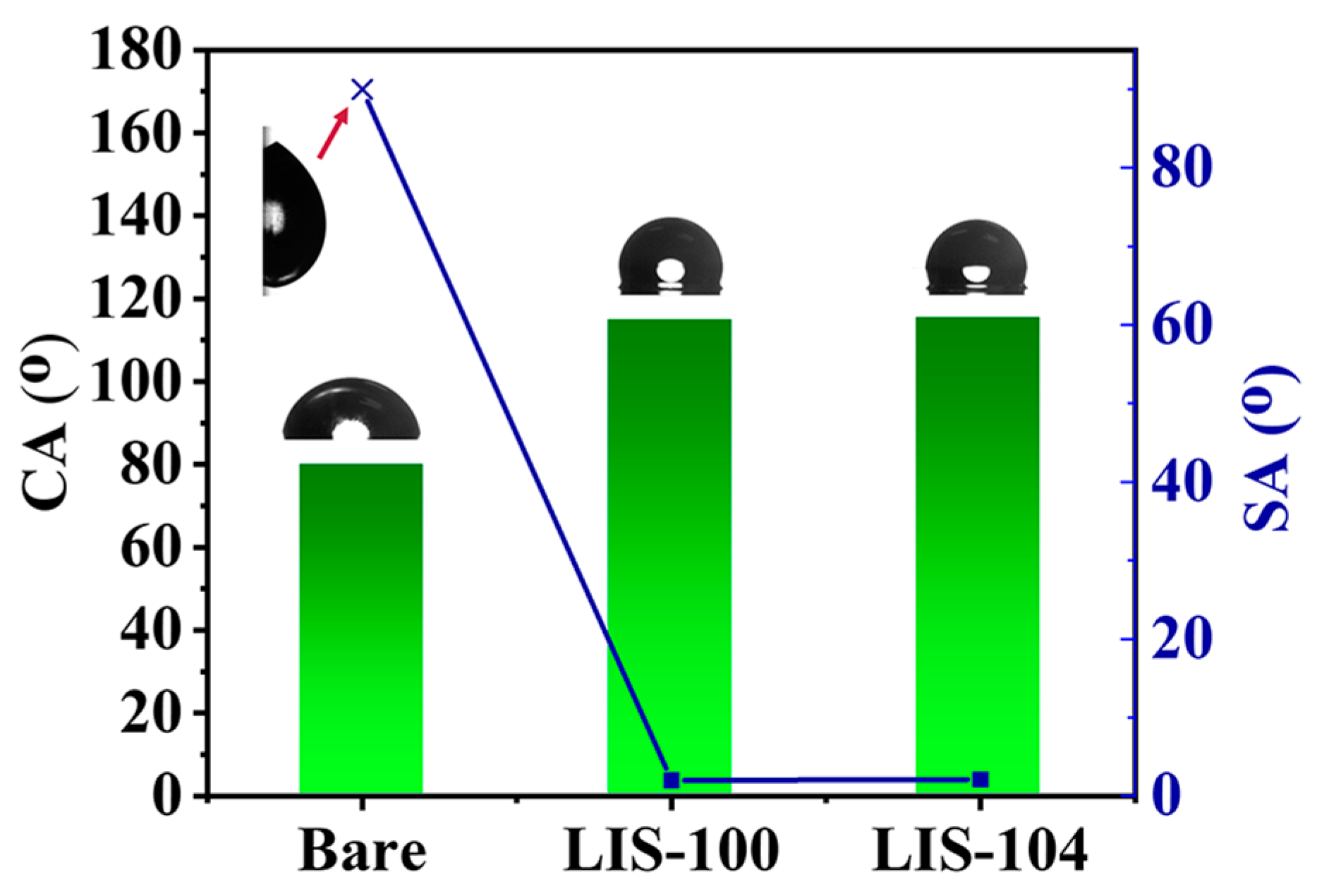
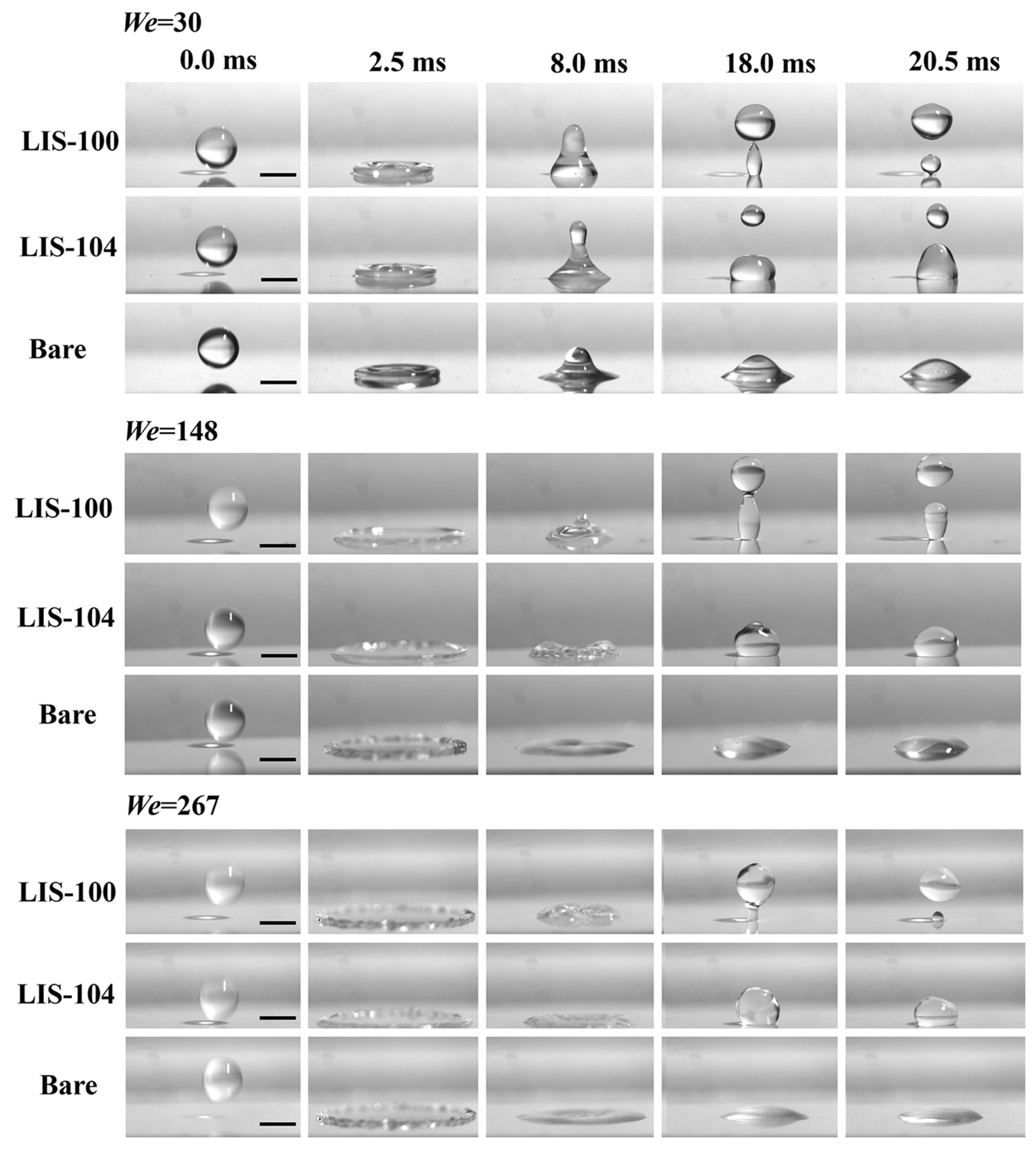

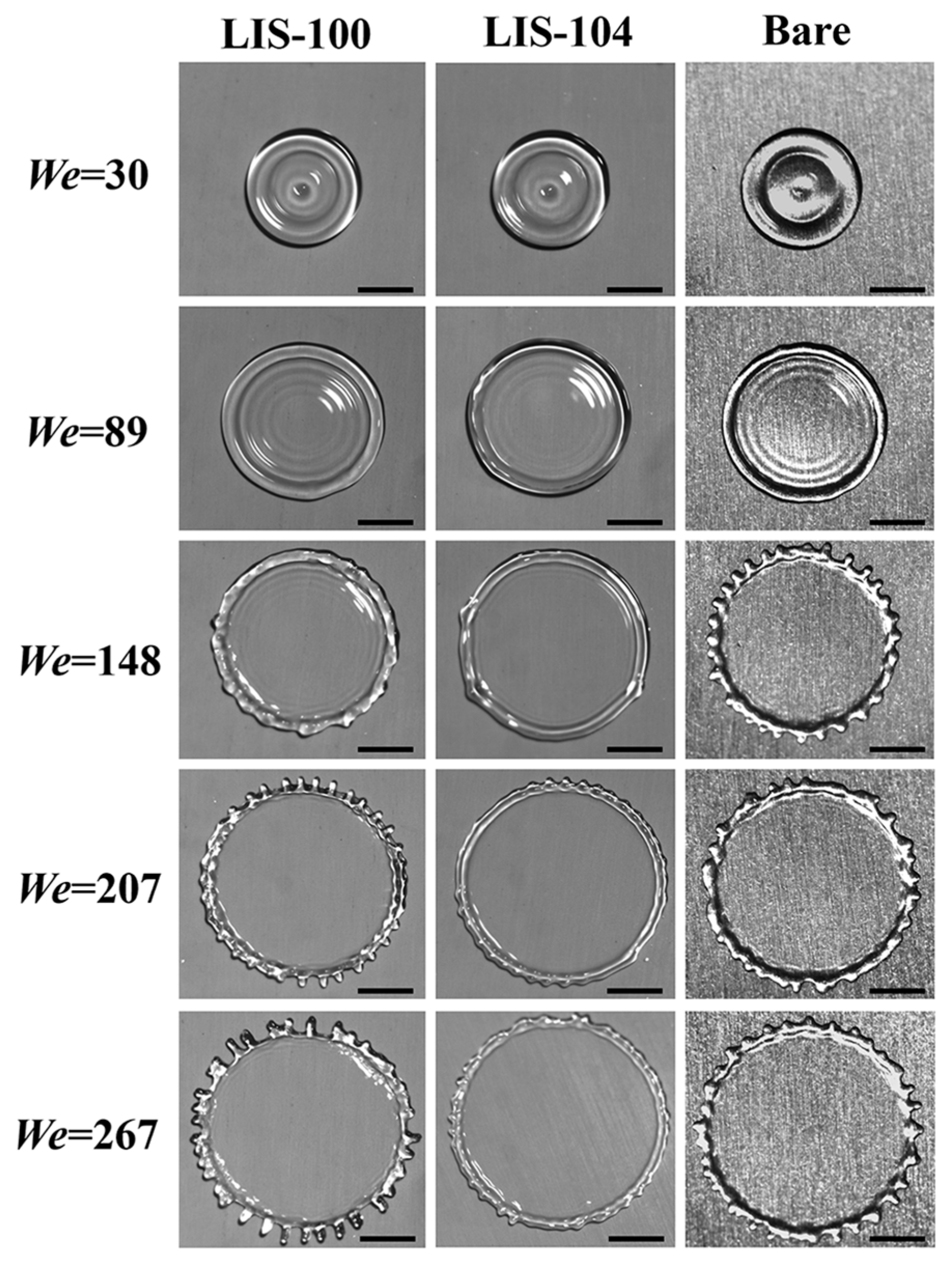

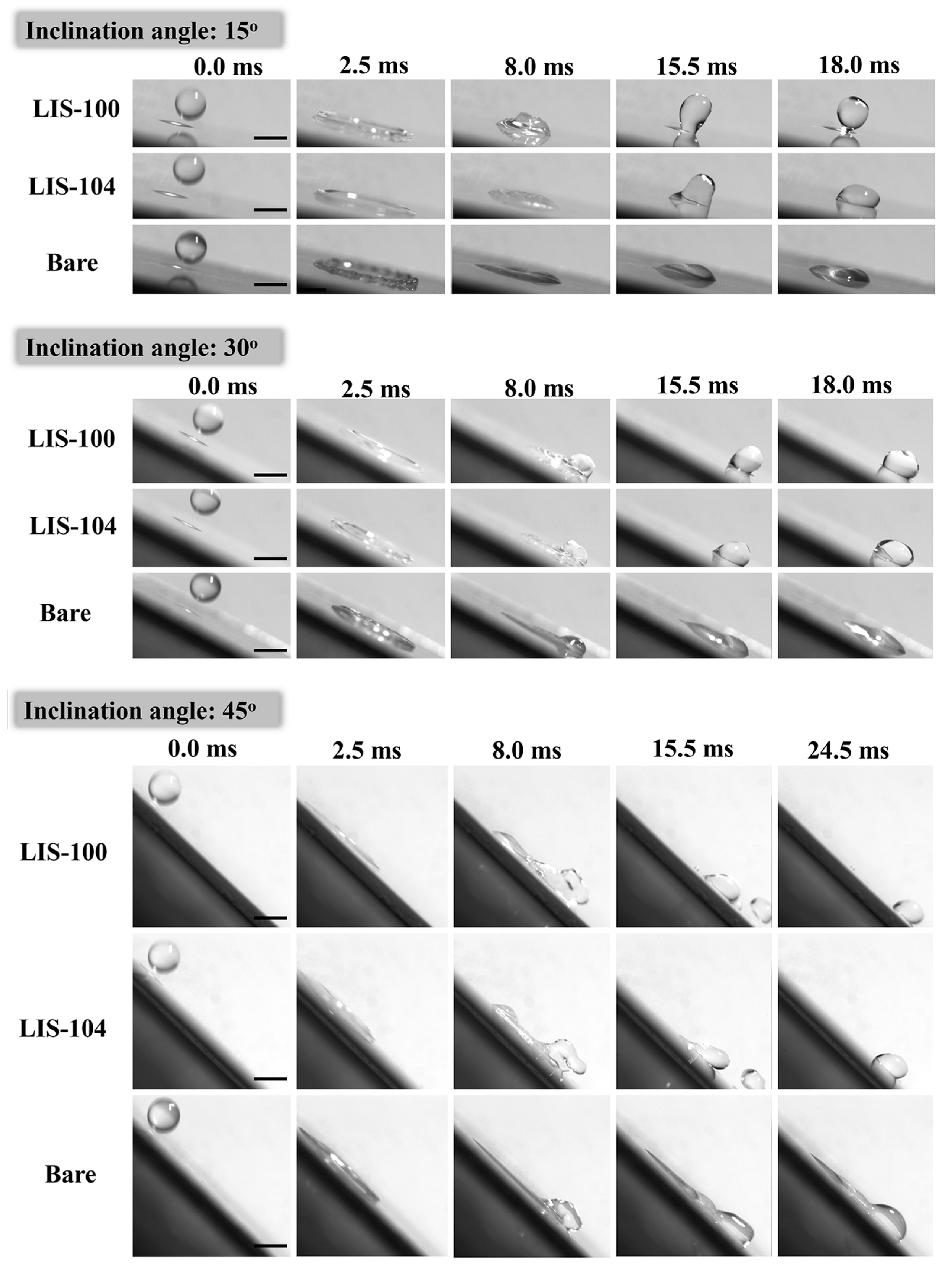
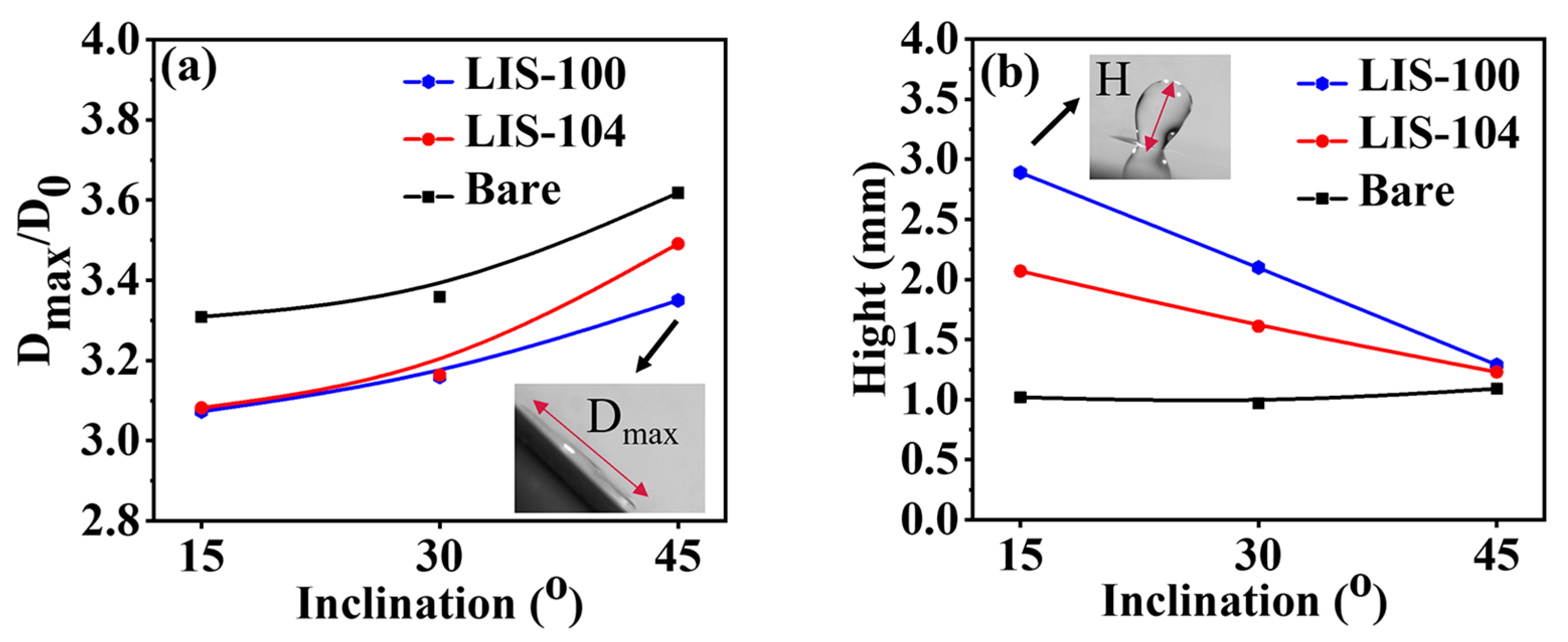

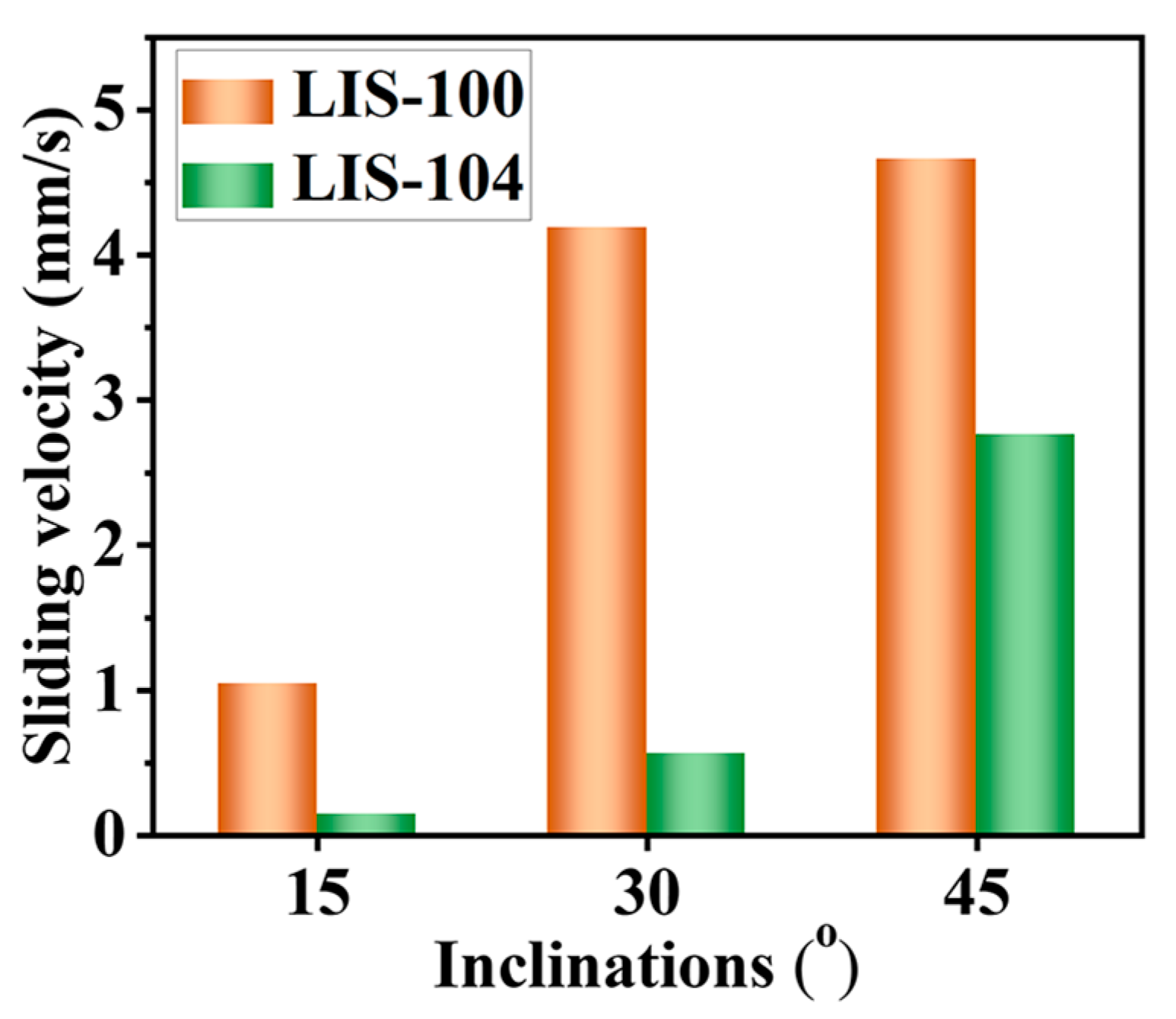
| Falling Height (cm) | Droplet Radius (mm) | Impact Velocity (m/s) | We |
|---|---|---|---|
| 5 | 1.10 | 0.98 | 30 |
| 15 | 1.10 | 2.94 | 89 |
| 25 | 1.10 | 4.90 | 148 |
| 35 | 1.10 | 6.86 | 207 |
| 45 | 1.10 | 8.82 | 267 |
| Parameters | R | γw (mN/m) | γo (mN/m) | γwo (mN/m) | θw (°) | θo (°) | ∆E1 (mN/m) | ∆E2 (mN/m) |
|---|---|---|---|---|---|---|---|---|
| GPL 100 | 4.9 | 72 | 17 | 27 | 102.5 | 10.0 | 132.3 | 214.3 |
| GPL 104 | 4.9 | 72 | 19 | 56 | 102.5 | 17.1 | 110.3 | 219.3 |
Disclaimer/Publisher’s Note: The statements, opinions and data contained in all publications are solely those of the individual author(s) and contributor(s) and not of MDPI and/or the editor(s). MDPI and/or the editor(s) disclaim responsibility for any injury to people or property resulting from any ideas, methods, instructions or products referred to in the content. |
© 2023 by the authors. Licensee MDPI, Basel, Switzerland. This article is an open access article distributed under the terms and conditions of the Creative Commons Attribution (CC BY) license (https://creativecommons.org/licenses/by/4.0/).
Share and Cite
Li, B.; Fan, L.; Bai, J.; Xiang, H.; Yuan, Y. Water-Droplet Impact and Sliding Behaviors on Slippery Surfaces with Various Weber Numbers and Surface Inclinations. Coatings 2023, 13, 264. https://doi.org/10.3390/coatings13020264
Li B, Fan L, Bai J, Xiang H, Yuan Y. Water-Droplet Impact and Sliding Behaviors on Slippery Surfaces with Various Weber Numbers and Surface Inclinations. Coatings. 2023; 13(2):264. https://doi.org/10.3390/coatings13020264
Chicago/Turabian StyleLi, Bo, Lei Fan, Jie Bai, Huiying Xiang, and Yuan Yuan. 2023. "Water-Droplet Impact and Sliding Behaviors on Slippery Surfaces with Various Weber Numbers and Surface Inclinations" Coatings 13, no. 2: 264. https://doi.org/10.3390/coatings13020264
APA StyleLi, B., Fan, L., Bai, J., Xiang, H., & Yuan, Y. (2023). Water-Droplet Impact and Sliding Behaviors on Slippery Surfaces with Various Weber Numbers and Surface Inclinations. Coatings, 13(2), 264. https://doi.org/10.3390/coatings13020264







